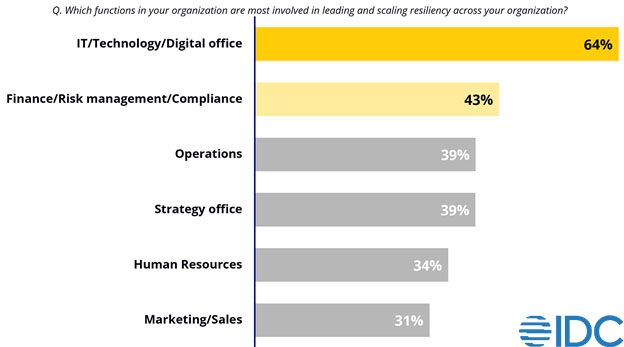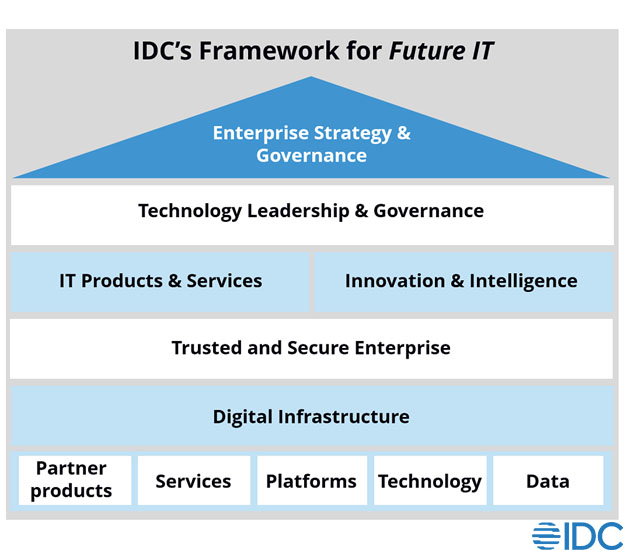The economist Brian Arthur posits that technologies form the economy’s structure, and that this structure changes continuously as technologies evolve. Our current period of multiple crises has considerably accelerated this continual creation and recreation of the economy; now, digital technology is front and center. As a result, IT has become the business’s operating system, and CIOs must reinvent their IT organizations to deliver the capabilities of a successful, competitive, and adaptable future enterprise.
Why would CIOs change their role?
The CIO’s role has become ascendant — largely because of the post-pandemic competitive environment. We see the light at the end of the tunnel of the pandemic, and CIOs must now adapt and align IT with the requirements of the emergent future enterprise in the next normal.
Today, CIOs are crucial players in leading and scaling resiliency. A recent worldwide survey of 790 executives establishes that 64% of organizations seek leadership from IT and other digital heads.

Source: Future Enterprise Resiliency & Spending Survey Wave 2, IDC, February 2021
In 42% of organizations, the IT function develops and executes business continuity plans and resiliency initiatives collaboratively with business units. More data is available at Future IT Leadership Strategies: Insights from IDC’s Global Survey Research.
In the longer term, CIOs must navigate IT transformations to deliver the capabilities of a successful, competitive, and nimble enterprise in the digital economy. To achieve this mission, IT organizations need to fulfill four crucial roles:
- Architecting, orchestrating, integrating, and managing ecosystems of digital technologies and assets from disparate and evolving sources
- Building organizational resilience, agility, scalability, and security
- Leading and governing the evolution of enterprise and ecosystem digital infrastructure, products, services, and experiences
- Creating innovation factories that deliver sustainable streams of custom software and novel digital technology applications
Transforming the IT organization
The need to transform IT is exciting, but it’s nonetheless quite a tall order for most IT organizations. And many IT executives wonder: “Where do we start?”
IDC research shows that it is essential for an organization to assess the competency and maturity of its IT organization and its ability to support a digital enterprise. IT leaders need to rethink what is critical and evaluate where the organization stands as they manage complex changes. The traditional approaches of strategy and planning and the annual production of a 3-year plan that worked in a predictable context have become obsolete or misaligned with the uncertainty IT faces. “We are moving into an adaptive approach to technology planning and implementation so we can quickly respond to customer feedback,” a CIO in insurance recently told us.
Some of the new best practices that work today are:
- Focus on running the current business while preparing for the future
- Coordinate transformation initiatives to build resilience and adaptability with modular architectures
- Create federated governance empowering the LOB in decision making
- Build broader digital resilience capabilities that can be deployed rapidly to address a wide range of events and scenarios
- Partner with LOB technologists to form a virtual software innovation factory
- Create centers of excellence (COE) for development practices and tools, AI and machine learning, CX design, and other critical digital capabilities to build cross-enterprise digital innovation muscle
- Make the enterprise trust and security culture a differentiator for the business
- Develop compliance and risk management beyond mandatory requirements to create unique stakeholder values
However, not everything has changed or is new. The IT environment remains a hybrid between what is complicated but known and what is complex and unpredictable. And hybrid approaches reign.
A framework can help to get there
As another CIO in manufacturing said, “When you have frameworks in place to achieve the initiatives your organization is implementing, you create structured ways for people to be successful. At the same time, you solidify your vision, leadership, and strategy.”
Please read Quick Market Insights, 2021: Chapter 3 — The Journey to Future IT, or watch the video for more CIOs’ insights. Future IT is the operating system of the Future Enterprise, providing the systems and capabilities enabling the organization to run the current business and create, implement, and evolve new business models at digital speed. Check out the new IDC study, IDC MaturityScape: Future IT 1.0, where we discuss the dimensions to consider when building the IT organization of the future.

- Technology Leadership & Governance: CIOs rise to the crises’ challenges and the journey to recovery
- Trusted and Secure Enterprise: With serial crises and escalating attacks, CIOs are crucial in protecting trust and building resilience
- Digital Infrastructure: IT organizations orchestrate a complex business and IT technology transition
- IT Products and Services: IT organizations support resilience, customers’ changing needs, new business models, instrumentation
- Innovation & Intelligence: CIOs implement intelligent capabilities and help LOBs foster innovation at the edge; CIOs empower workers with AI and accelerate automation
If you would like to learn more, please join us for the Future IT: Transforming the IT Organization for the Future Enterprise webinar on June 2nd at 11 AM/EST. We’ll talk about how to optimize your IT organization to deliver the future that your business wants and needs.




